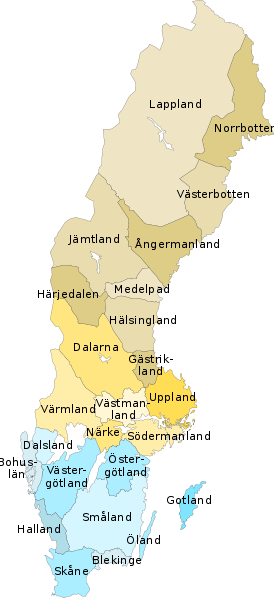Sweden is divided into 25 Provinces (Landskap) and they have no administrative function, that function was transferred to the Counties of Sweden (Län) in 1634. The Provinces of Sweden are historical, geographical and cultural regions. Many people feel a greater affinity with the Provinces than to the County they live in. It’s the Provinces rather than the County that Swedes tend to indicate as their homeland.
The Provinces are grouped into three
unofficial parts (the lands of Sweden)
Götaland (Gothia) is the southern, most densely populated part, consisting of ten provinces.
Svealand (Swealand or Sweden proper) is the central part, named after the historic Sweden proper, which is the smallest of the three parts with six provinces.
Norrland (Northland) is the northern part, which is the largest of the three, covering 60 percent of the Swedish territory with nine provinces.
These three regions are commonly named in Swedish weather reports, therefore their boundaries can often be seen on television and on the weather maps in the press and Daily News Magazines. Still they have no administrative function and no coats of arms.
.
Sweden’s 25 Provinces
- Blekinge (Blechingia*)

- Bohuslän (Bahusia*)
- Dalarna (Dalecarlia*)
- Dalsland (Dalia*)
- Gotland (Gotlandia*)
- Gästrikland (Gestricia*)
- Halland (Hallandia*)
- Hälsingland (Helsingia*)
- Härjedalen (Herdalia*)
- Jämtland (Jemtia*)
- Lappland (Lapponia*)
- Medelpad (Medelpadia*)
- Norrbotten (Norbothnia*)
- Närke (Nerike*)
- Skåne (Scania*)
- Småland (Smolandia*)
- Södermanland (Sudermannia*)
- Uppland (Uplandia*)
- Värmland (Wermlandia*)
- Västermanland (Vestmannia*)
- Västerbotten (Vestrobothnia*)
- Västergötland (Westro Gothia*)
- Ångermanland (Angermannia*)
- Öland (Olandia*)
- Östergötland (Ostro Gothia*)
.
* Latin forms used occasionally in English and some other non-Swedish languages, the exception being Scania which is the “normal” form in English.